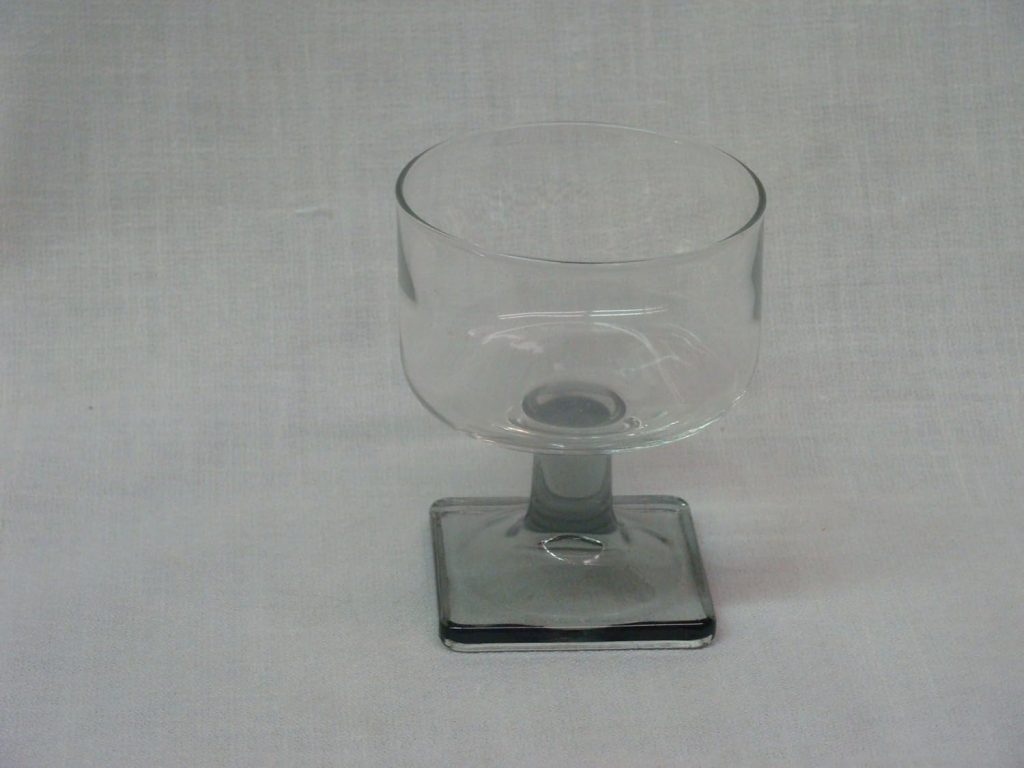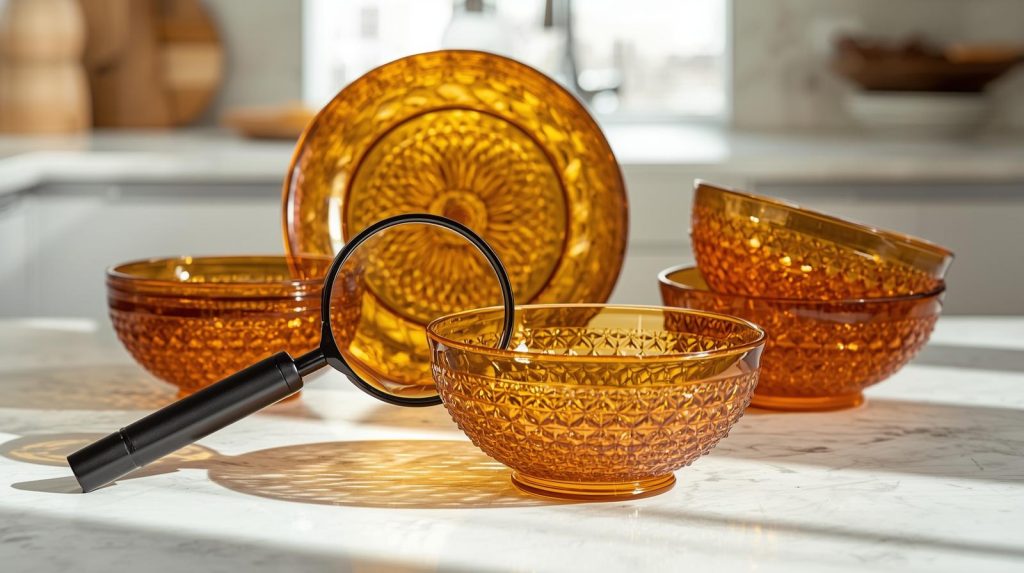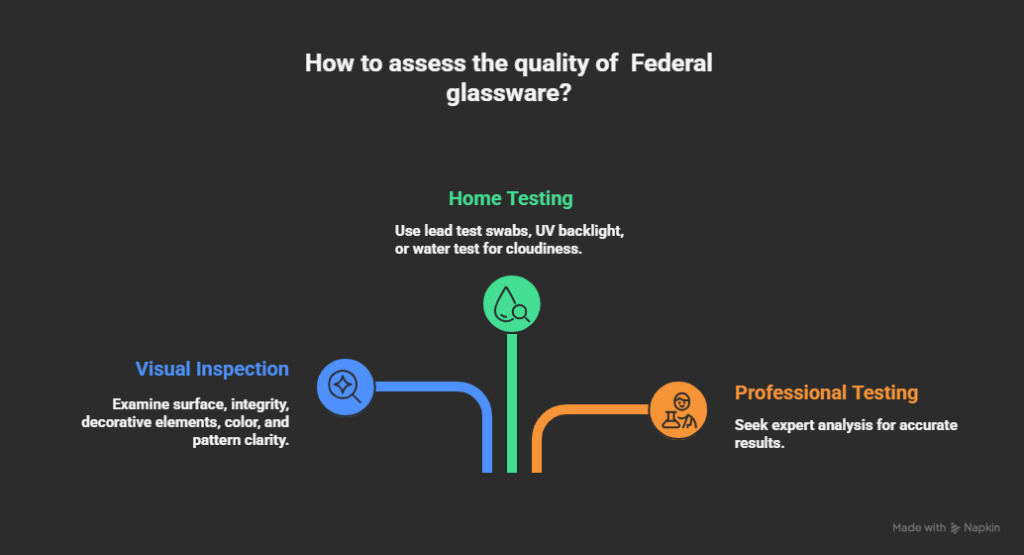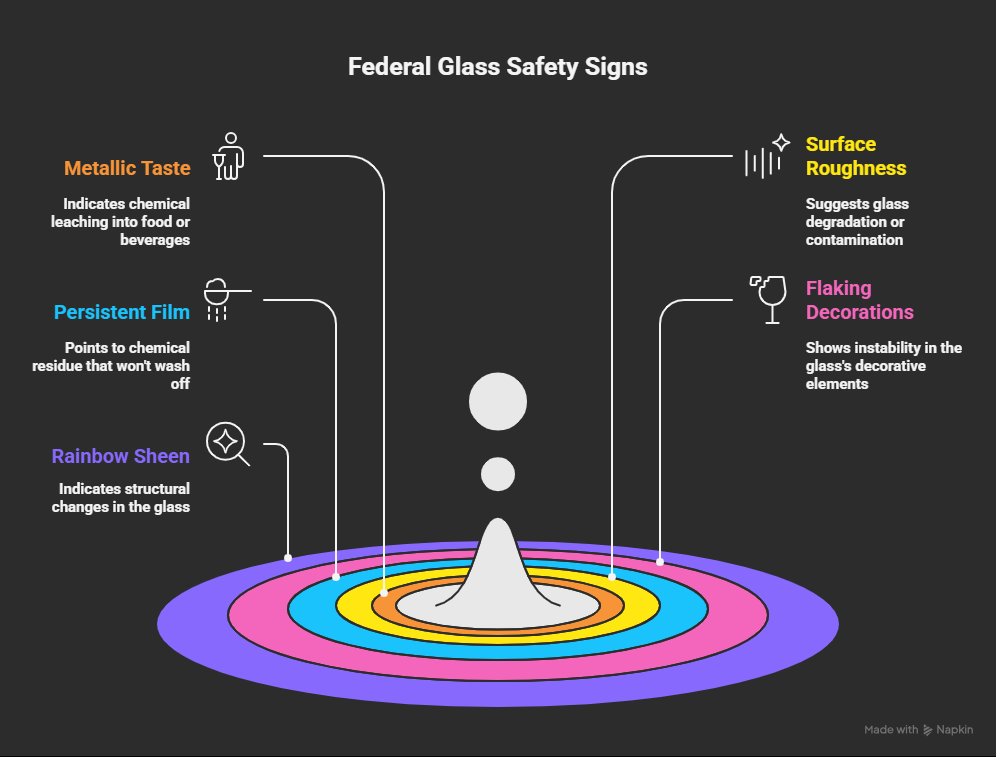You’ve just inherited your grandmother’s beautiful glass dessert dishes, or perhaps you scored an amazing find at an estate sale, a complete set of vintage Federal Glass in that gorgeous amber color.
But before you serve your famous trifle in these treasured pieces, a nagging question keeps you up at night: Is Federal Glass safe to use?
You’re not alone in this concern. With growing awareness about lead and other heavy metals in vintage dishware, collectors and homeowners are rightfully questioning whether their beloved Federal Glass pieces pose health risks.
The good news? Federal Glass safety isn’t a simple yes-or-no answer, but with the right information, you can make an informed decision about whether to use, display, or retire your vintage pieces.
In this comprehensive guide, we’ll explore the safety concerns surrounding Federal Glass, examine whether it contains lead, and provide actionable steps to determine if your specific pieces are safe for food contact.
What is Federal Glass? A Brief History
The Federal Glass Company operated in Columbus, Ohio, from 1900 to 1979, making it one of America’s most prolific glassware manufacturers during the Depression era and beyond.
During its nearly 80-year run, Federal produced everything from affordable everyday dishes to decorative pieces that millions of American families relied on.
Federal Glass is perhaps best known for its Depression-era patterns, including Colonial (“Knife and Fork”), Georgian (also called “Lovebirds”), Madrid, Mayfair, Sharon (“Cabbage Rose”), and Normandie.

These patterns came in various colors—pink, amber, green, crystal clear, and occasional blue pieces, making them highly collectible today.
What makes Federal Glass so common in homes today? The company produced massive quantities of affordable glassware, often distributed as promotional items at gas stations, movie theaters, and grocery stores.
Your grandmother likely collected these pieces one by one during weekly shopping trips, which is why complete sets are still found in attics and estate sales across America.
Federal Glass pieces typically feature distinctive patterns, maker’s marks (often an “F” within a shield), and characteristic Depression-era styling with geometric or floral motifs pressed into the glass surface.
The Main Safety Concerns with Federal Glass
Before we answer whether Federal Glass is safe, let’s understand what potential hazards you or collectors worry about:
Lead Content in Glass
Lead has historically been added to glass to enhance clarity, weight, and brilliance, creating what is known as “lead crystal.”
However, lead can leach from glass into food and beverages, particularly when exposed to acidic substances, heat, or prolonged storage.
According to the Environmental Protection Agency (EPA), even low-level lead exposure can cause health problems, particularly in children and pregnant women, affecting brain development and causing various neurological issues.
The critical question collectors ask: Does vintage Federal Glass contain lead? The answer depends on the specific type and pattern.
Most standard Federal Glass produced for everyday use was made from soda-lime glass, which typically does not contain lead.
Federal Glass was primarily mass-produced, affordable tableware rather than premium lead crystal.
However, some decorated pieces, particularly those with painted or metallic trim, may have lead-containing decorative elements.
Uranium and Manganese in Colored Glass
Many colored vintage glass pieces, including some Federal Glass items, contain small amounts of uranium oxide or manganese dioxide.
These elements were used to create distinctive colors. Uranium created vibrant yellow-green “Vaseline glass,” while manganese produced pink and amber hues, just like in Fiesta designs linked to its radioactivity concerns.
While the word “uranium” understandably causes alarm, the radioactivity in uranium glass is extremely low.
The U.S. Nuclear Regulatory Commission (NRC) states that uranium glass typically contains up to about 2% uranium by weight, and the radiation emitted by such glass is very low, comparable to natural background radiation.
According to the NRC publication NUREG-1717, the radiation exposure from uranium glass is minimal, with estimated effective doses around 4 millirems (mrem) per year, which is approximately 1 to 2% of the average American’s annual radiation exposure.
This level of radiation is considered negligible and safe under normal handling and display conditions.
Surface Deterioration and Cloudiness
Over decades, glass can develop “sick glass” syndrome—a cloudy, sometimes iridescent appearance caused by alkaline elements leaching from the glass surface.
This deterioration, while aesthetically unpleasing, can indicate that the glass structure is breaking down.
When glass deteriorates, any trace elements within it become more likely to leach into food or beverages.
Cadmium in Decorative Elements
Some vintage glassware features painted decorations, gold or silver trim, or colored enamels.
These decorative elements sometimes contained cadmium or lead, particularly in red, orange, and yellow colors.
The Consumer Product Safety Commission (CPSC) has established strict limits for lead and cadmium in modern dishware, but vintage pieces predate these regulations.
Is Federal Glass Safe to Use? The Direct Answer

Here’s the straightforward answer you need: Most plain, undecorated Federal Glass in good condition is generally safe for occasional use, but with important caveats.
Let’s break this down by category:
Clear and Plain Federal Glass (Generally Safe)
Standard clear Federal Glass patterns like Colonial, Georgian, and similar pressed glass patterns were manufactured using basic soda-lime glass formulations.
These pieces typically do not contain significant lead content. The Federal Glass Company focused on mass-market, affordable products rather than premium lead crystal, which was more expensive to produce.
A study by the National Institute of Environmental Health Sciences found that most Depression-era pressed glass contained minimal to no detectable lead in the glass matrix itself.
This makes plain Federal Glass pieces substantially different from contemporary European lead crystal or more recent concerns about lead in decorative ceramics (similar to questions collectors have about whether Rosenthal china contains lead or if Myott china contains lead.
Colored and Decorated Pieces (Use with Caution)
Colored Federal Glass—particularly pink, amber, green, and blue pieces—requires more careful consideration.
While the glass base is likely lead-free, the colorants themselves warrant attention:
- Pink and Amber pieces: Often colored with manganese or selenium compounds, generally considered safe but best avoided for acidic foods or hot liquids.
- Green and yellow-green pieces: May contain uranium oxide (creating that distinctive glow under UV light), which poses minimal radiation risk, but some collectors prefer display-only use.
- Painted or gilded decorations: Any Federal Glass with painted designs, metallic trim, or enameled decorations should be treated with caution, as these elements may contain lead or cadmium.
Damaged or Deteriorated Glass (Avoid Food Contact)
Federal Glass showing any of these conditions should not be used for food or beverages:
- Cloudiness or haziness that won’t clean off (“sick glass”)
- Flaking, chipping, or rough edges
- Iridescent surface film
- Visible crazing or internal cracks
- Worn or flaking decorative elements
When glass deteriorates, its structure becomes compromised, potentially releasing any elements within the glass matrix.
Additionally, damaged glass can harbor bacteria in microscopic cracks and poses physical injury risks from sharp edges.
FDA Perspective on Vintage Glassware
The FDA’s current standard for lead release from ceramic and glass-ceramic cookware limits leachable lead to 0.5 micrograms per milliliter (μg/mL) for small hollowware.
These standards apply to new products and ensure ceramic ware sold in the U.S. meets these safety limits.
However, vintage dishware, such as Federal Glass produced before these regulations came into force, has generally not been retroactively tested by the FDA to meet these modern standards.
Vintage ceramics often contain higher lead levels because lead was historically used in glazes and paints for durability and vibrant colors, especially before 1971, when no federal limits existed.
Although the FDA began enforcing limits on lead in ceramics in 1971 and has increasingly tightened these limits since then, older items remain outside these norms, posing potential lead exposure risks when used for food or drink.
Therefore, vintage dishware typically lacks verification to modern lead-release safety standards, and consumers should be cautious about their use with food.
How to Determine If Your Federal Glass Is Safe

Rather than making blanket assumptions, here’s how to assess your specific Federal Glass pieces:
Visual Inspection Checklist
Examine each piece carefully:
✓ Surface Condition: Is the glass clear and smooth, or cloudy and rough?
✓ Structural Integrity: Any chips, cracks, or internal stress lines?
✓ Decorative Elements: Does it have painted designs, metallic trim, or enameling?
✓ Color Intensity: Unusually vibrant colors (especially yellows and greens) may indicate uranium content
✓ Pattern Clarity: Are the pressed patterns sharp, or worn and degraded?
Any piece failing these visual checks should be relegated to display-only status.
Testing Methods You Can Use at Home
Lead Test Swabs: Available at hardware stores and online (3M LeadCheck is a popular brand), these swabs change color when they contact lead.
Test any painted or decorated areas, not the plain glass surface itself. Follow the manufacturer’s instructions carefully.
Note that these tests work best on surfaces where lead is accessible; they may not detect lead deep within the glass matrix, but they’ll identify lead in decorative elements where it poses the greatest risk.
UV Blacklight Test: If you suspect uranium glass, a simple UV blacklight (available for $10-20) will cause uranium-containing glass to fluoresce bright green.
While this doesn’t indicate danger, it confirms uranium content, helping you make an informed decision about use versus display.
Remember, uranium glass radiation exposure from normal use is considered negligible by experts.
The Water Test for Cloudiness: Fill the glass with water and observe. Permanent cloudiness that doesn’t improve when wet suggests glass degradation.
This type of deterioration means the glass structure is compromised.
When to Seek Professional Testing
Consider professional laboratory testing (typically $20-50 per item through companies like ProLab or Environmental Testing and Research Labs) if:
- You plan to use the pieces regularly for food service
- The pieces have significant monetary or sentimental value
- You’re serving food to children or pregnant women
- The glass has decorative elements you’re uncertain about
- You’re selling the pieces and want to certify their safety
Professional X-ray fluorescence (XRF) testing can definitively identify lead, cadmium, and other heavy metals in both the glass matrix and decorative elements.
Warning Signs to Never Ignore

If your Federal Glass exhibits any of these characteristics, do not use it for food or beverages:
- A metallic taste when you drink from the glass
- Surface roughness that feels gritty or sandy
- Film or residue that returns after washing
- Flaking decorations that come off during cleaning
- Visible rainbow sheen (iridescence) on the surface
These signs indicate chemical instability or degradation that makes the glass unsafe for food contact.
Safe Usage Guidelines for Federal Glass
If you’ve determined your Federal Glass is in good condition and shows no warning signs, follow these guidelines to minimize any potential risks:
Best Practices for Food Contact
Do:
- Use for dry foods (cookies, crackers, candies)
- Employ for short-term beverage service (serving and consuming within an hour)
- Hand wash gently with mild dish soap and warm water
- Dry immediately with a soft cloth
- Store with padding between stacked pieces
- Rotate use among pieces to prevent overuse of individual items
Don’t:
- Store acidic foods (citrus, tomatoes, vinegar-based items) for extended periods
- Use for hot beverages or foods above 150°F
- Put in the dishwasher (harsh detergents and high heat can degrade glass)
- Use in the microwave (thermal stress can cause hidden cracks)
- Use for overnight or long-term food storage
- Serve foods to infants, young children, or pregnant women (apply extra caution)
The Acid Test Principle
Acidic substances are particularly effective at leaching elements from glass and ceramics.
A 2012 study in Environmental Research by Feraille and Van Loco demonstrated that acidic foods significantly increase lead release from vintage dishware.
This is why you should avoid using vintage Federal Glass for:
- Citrus juices and fruits
- Tomato-based sauces
- Vinegar dressings
- Wine or acidic cocktails
- Pickled foods
- Carbonated beverages
If you love your Federal Glass amber sherbet dishes, fill them with ice cream rather than citrus sorbet!
Cleaning Methods That Won’t Damage Your Pieces
Proper care extends both the life and safety of Federal Glass:
- Hand wash only with lukewarm water and mild, phosphate-free dish soap
- Avoid abrasive scrubbers—use soft sponges or cloths
- Never use harsh chemicals like bleach, ammonia, or abrasive cleansers
- Skip the dishwasher entirely—the combination of harsh detergents, high heat, and water pressure accelerates glass deterioration
- Dry immediately to prevent water spots and mineral buildup
- Remove stuck-on food by soaking it in warm water rather than scrubbing aggressively.
Some collectors successfully maintain their Federal Glass for decades by treating each piece as they would fine china with respect and gentle handling.
Alternatives and When to Display vs. Use
Sometimes the wisest decision is to admire your Federal Glass without using it for food. Here’s when display is the better option:
When Display Is the Better Choice
Choose display over use if your Federal Glass:
- Has significant collector value (rare patterns or colors)
- Shows any deterioration or damage
- Features decorative elements with uncertain composition
- Contains uranium (for collectors who prefer extra caution)
- Holds special sentimental value that would be diminished by accidental damage
- Will be in a home with young children who might accidentally break pieces
Much like collectors debate whether Indiana Glass contains lead and often choose display over use for valuable pieces, Federal Glass collectors face similar decisions.
Modern Alternatives for Collectors
If you love the Depression-era aesthetic but want guaranteed safety:
Modern Reproductions: Several companies produce Depression glass reproductions in original patterns using modern, lead-free glass formulations.
While purists may scoff, these pieces offer the visual appeal without safety concerns.
Contemporary Colored Glass: Modern colored glassware from companies like Mosser Glass and Fenton (before its 2011 closure) provides similar aesthetics with contemporary safety standards.
Display-Safe Alternatives: Use your vintage Federal Glass for decorative purposes while serving food in modern glass.
Your grandmother’s pink Sharon pattern bowls can hold potpourri, decorative balls, or sit empty as beautiful accent pieces.
Creative Non-Food Uses for Federal Glass
Repurpose your Federal Glass pieces safely:
- Vanity organization: Store cotton balls, Q-tips, or jewelry
- Office supplies: Hold paper clips, rubber bands, or pushpins
- Craft storage: Organize buttons, beads, or sewing notions
- Planter bases: Use as cachepots for small potted plants (with a liner)
- Candle holders: Place tea lights or votives inside (avoid direct flame contact)
- Decorative vignettes: Create seasonal displays on shelves or mantels
- Guest room accents: Display with flowers or as elegant soap dishes
These uses let you enjoy your collection daily without any food-safety concerns.
Federal Glass Safety: Making Your Decision
After examining the evidence, here’s how to make an informed decision about your Federal Glass:
The Conservative Approach: If you have any doubts, display your Federal Glass rather than use it.
This zero-risk strategy protects your health while preserving your collection’s value and longevity.
This is especially prudent if you’re serving children, pregnant women, or individuals with compromised immune systems.
The Moderate Approach: Use plain, undecorated Federal Glass in excellent condition for occasional, dry food service or brief beverage use, while avoiding acidic foods, hot liquids, and prolonged storage.
Test any decorated pieces with lead swabs and restrict decorated items to display only.
The Informed Risk Approach: After testing and inspection, use your Federal Glass regularly for appropriate foods, following all safety guidelines about avoiding acids, heat, and deteriorated pieces.
Accept that absolute certainty is impossible with vintage items, but make educated choices based on available evidence.
Remember, even collectors who love their Federal Glass often keep a few special pieces for use while displaying the rest.
There’s no requirement to use every piece you own—sometimes admiring beauty is enough.
Frequently Asked Questions About Federal Glass Safety
Does all Federal Glass contain lead?
No, most Federal Glass was made from standard soda-lime glass without significant lead content.
Federal Glass Company produced mass-market, affordable tableware rather than premium lead crystal. However, decorative elements (painted designs, metallic trim) on some pieces may contain lead.
The glass base itself, in plain Federal patterns, is generally lead-free.
Can I microwave Federal Glass?
No, you should never microwave Federal Glass or any vintage glassware. Microwaving causes rapid, uneven heating that can create thermal stress, potentially causing the glass to crack or shatter.
Additionally, any trace elements in the glass may become more likely to leach under high-heat conditions. Vintage glass was not designed or tested for microwave use.
Purchase an inexpensive UV blacklight (wavelength 365-395nm) and shine it on your glass in a dark room. Uranium-containing glass will fluoresce bright yellow-green.
This distinctive glow confirms uranium content, though remember that uranium glass poses minimal health risk.
Many collectors specifically seek this characteristic, as it confirms authentic vintage production.
Cloudiness that won’t wash off indicates “sick glass” syndrome—chemical deterioration where alkaline elements are leaching from the glass structure.
While not immediately dangerous to touch, this compromised glass should not be used for food or beverages because the structural breakdown makes any trace elements more likely to leach, and the surface can harbor bacteria in microscopic irregularities.
While value isn’t directly related to safety, the most sought-after Federal Glass patterns include Madrid in amber, Mayfair (“Open Rose”) in pink or blue, Sharon (“Cabbage Rose”) in pink, and rare colors of common patterns.
However, valuable doesn’t mean unsafe—it simply means you might prefer display over use to preserve condition and value.
No, avoid using Federal Glass for hot beverages. Heat increases the likelihood of leaching any trace elements from glass into liquids.
Additionally, rapid temperature changes can cause thermal shock, potentially cracking vintage glass that may have invisible stress fractures from decades of use.
Purchase lead test swabs (like 3M LeadCheck) and test any painted, enameled, or metallic decorative elements.
These swabs turn pink or red when they contact lead. Test multiple spots on decorated areas.
While these tests won’t detect lead deep within the glass matrix, they’ll identify lead in surface decorations where it poses the greatest risk to users.
Conclusion: Balancing Beauty, History, and Safety
Federal Glass represents a tangible connection to American history—pieces that graced millions of tables during challenging economic times and became treasured heirlooms passed through generations.
The question of whether Federal Glass is safe to use doesn’t have a universal answer because “Federal Glass” encompasses hundreds of patterns, colors, and production runs spanning nearly 80 years.
The key takeaways for your collection
Most plain, undecorated Federal Glass in excellent condition was made from basic soda-lime glass without significant lead content.
These pieces are generally safe for occasional use when you follow proper guidelines—avoiding acids, heat, and prolonged storage, while inspecting regularly for deterioration.
Colored and decorated Federal Glass requires more caution. Test decorative elements for lead, consider the implications of uranium or manganese colorants, and perhaps restrict these pieces to display or very limited use.
Any Federal Glass showing cloudiness, chips, cracks, or deterioration should be retired from food service immediately, regardless of pattern or color.
Ultimately, only you can decide the right balance between using and preserving your Federal Glass.
Some collectors believe these pieces were made to be used and enjoyed, while others prefer preserving them as display-worthy artifacts.
Both approaches honor the craftsmanship and history these pieces represent.
Take action today
- Inspect your Federal Glass collection piece by piece
- Test any decorated items with lead swabs
- Make informed decisions about which pieces to use versus display
- Follow safe usage guidelines for any pieces you continue using
- Consider consulting a professional testing service for valuable or questionable items
Your grandmother’s Federal Glass dishes carried meals and memories for decades.
With informed caution, you can continue that tradition safely or honor those memories by displaying these beautiful pieces where they can be admired for generations to come.
Disclaimer: This article provides general information about Federal Glass safety based on available research and expert guidelines. It is not a substitute for professional testing or expert consultation. When in doubt about any vintage dishware’s safety, consult a certified testing laboratory or choose display over use. The author and publisher assume no liability for decisions readers make regarding vintage glassware.